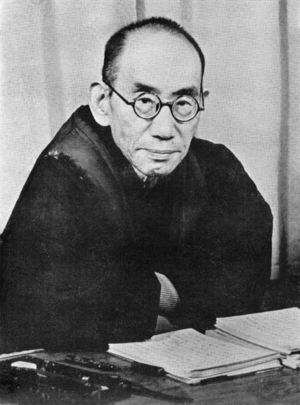Kitaro Nishida facts for kids
Quick facts for kids
Kitarō Nishida
|
|
|---|---|
 |
|
| Born | May 19, 1870 Unokema, Ishikawa, Japan
|
| Died | June 7, 1945 (aged 75) Kamakura, Kanagawa, Japan
|
| Nationality | Japanese |
| Alma mater | Tokyo Imperial University |
| Era | 20th-century philosophy |
| Region | Japanese philosophy |
| School | Kyoto School |
| Institutions | Kyoto Imperial University |
|
Main interests
|
Metaphysics, Aesthetics |
|
Notable ideas
|
|
|
Influenced
|
|
Kitarō Nishida (西田 幾多郎, Nishida Kitarō, May 19, 1870 – June 7, 1945) was a very important Japanese philosopher. He thought deeply about many things, including how we understand the world, what is right and wrong, and even about science and religion. He is known for starting a group of thinkers called the Kyoto School of philosophy.
Nishida studied at the University of Tokyo and finished his degree in philosophy in 1894. Later, he became a professor of philosophy at Kyoto University. He retired in 1927. In 1940, he received a special award called the Order of Culture for his contributions. He also helped start the Chiba Institute of Technology around that time.
Kitarō Nishida passed away at 75 years old from a kidney infection. His remains were buried in three different places. One part is in his family grave in his hometown. Another grave is at Tōkei-ji Temple in Kamakura, where his friend D. T. Suzuki held his funeral. The third grave is at Reiun'in, a temple in Kyoto.
Nishida's Ideas
Nishida was born when Japan was opening up to the world. This gave him a special chance to mix Eastern ideas, like those from Zen Buddhism, with Western philosophy. His goal was to bring these two ways of thinking closer together.
He wrote many books and essays, including a famous one called An Inquiry into the Good. His work laid the foundation for the Kyoto School of philosophy and inspired many of his students.
One of Nishida's most famous ideas is the logic of basho. Basho is a Japanese word that means "place." Nishida's idea of basho is a way of thinking that tries to go beyond just seeing things as either a "subject" (like you, the observer) or an "object" (like a chair you observe). He wanted to show how opposites can exist together in a dynamic, changing way. He called this "absolutely contradictory self-identity." It's like saying that two different things can be true at the same time, not in a confusing way, but in a way that helps us understand the world better.
In his book, An Inquiry into the Good, Nishida explored ideas about experience, reality, what is good, and religion. He believed that the deepest kind of experience is "pure experience." This is when you experience something directly without thinking too much about it. Nishida thought that people naturally want to find harmony and unity in their experiences, which is a key idea in Asian wisdom.
His Impact

Nishida's ideas were sometimes misunderstood. During World War II, some people criticized him for liking Western philosophy too much, saying he wasn't patriotic enough. But after the war, other people criticized him for focusing on traditional Japanese ideas like nothingness, saying he was too nationalistic.
However, Nishida believed that Western philosophy had its own kind of universal truth, but it wasn't the only one. He also thought that God was "indispensable and decisive" in understanding the world.
Main Works
Nishida Kitarō wrote many important books and essays. Here are some of his most well-known works:
- An Inquiry into the Good (1911)
- Thoughts and Experiences, Vol. 1 (1915)
- Intuition and Reflection in Self-Consciousness (1917)
- Problems of Consciousness (1920)
- Art and Morality (1923)
- From the Actor to the Seer (1927)
- The System of Universals according to Self-Consciousness (1930)
- The Determination of the Nothing by Self-Consciousness (1932)
- Fundamental Problems of Philosophy, Vol. 1: The World of Action (1933)
- Fundamental Problems of Philosophy, Vol. 2: The Dialectical World (1934)
- Problems of Japanese Culture (1940)
- Last Writings: Nothingness and the Religious Worldview (published after his death)
Translated Works
Many of Nishida's works have been translated into other languages so people around the world can read them.
English
- An Inquiry into the Good, translated by Masao Abe and Christopher Ives.
- Intuition and Reflection in Self-Consciousness, translated by Valdo H. Viglielmo, Takeuchi Yoshinori and Joseph S. O'Leary.
- Last Writings: Nothingness and the Religious Worldview, translated by David Dilworth.
- Place and Dialectic: Two Essays by Nishida Kitaro, translated by John W. M. Krummel and Shigenori Nagatomo.
French
- L’Éveil à soi, translated by Jacynthe Tremblay.
- De ce qui agit à ce qui voit, translated by Jacynthe Tremblay.
See also
- Meontology
- Nishi Shinichiro
- Nothingness
- Philosopher's Walk
- Soku hi

